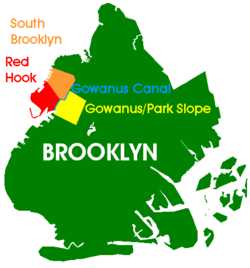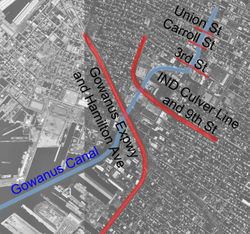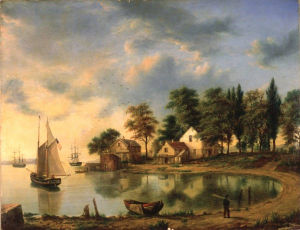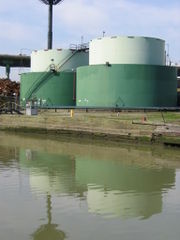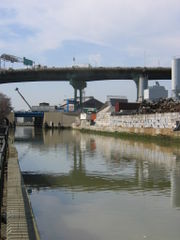Gowanus Canal
2007 Schools Wikipedia Selection. Related subjects: North American Geography
The Gowanus Canal, also known as the Gowanus Creek Canal, is a canal in the northwestern portion of the New York City borough of Brooklyn, New York, USA. Connected to Gowanus Bay in Upper New York Bay, the canal borders the neighborhoods of Red Hook and South Brooklyn on the west and Gowanus/ Park Slope on the east. There are five east-west bridge crossings over the canal, located at Union Street, Carroll Street, Third Street, Ninth Street, and Hamilton Avenue. The Gowanus Expressway ( Interstate 278) and the IND Culver Line of the New York City Subway, the only above-ground section of the original Independent Subway System, pass overhead.
Once a leading national industrial area, the canal's fate has mirrored the decline of traditional local shipping. A legacy of serious environmental problems has troubled the area for many decades, but in recent years there has been increasing pressure for environmental cleanup and waterfront economic development.
History
The Gowanus neighbourhood was originally a tidal inlet of navigable creeks in original saltwater marshland, and meadows teeming with fish and other wildlife. Henry Hudson and Giovanni da Verrazzano both navigated the inlet in their explorations of New York Harbour. The first land patents within Breukelen (Brooklyn), including the land of the Gowanus, were issued by the Dutch Government from 1630 to 1664. In 1639, the leaders of New Netherland made one of the earliest recorded real estate deals in New York City history with the purchase of the area around the Gowanus Bay for construction of a tobacco plantation. The early settlers of the area named the waterway "Gowanes Creek" after Gouwane, sachem of the local Lenape tribe called the Canarsee, who lived and farmed on the rich shorelines.
Adam Brouwer, who had been a soldier in the service of the Dutch West India Company, built and operated the first gristmill patented in NY and located at Gowanus (on land patented July 8, 1645, to Jan Evertse Bout). The tide-water gristmill on the Gowanus was the first in the town of Breukelen and was the first mill ever operated in New Netherlands (located north of Union, west of Nevin, and next to Bond street). This mill would later be known as Brower's Mill (also known as Freeks Mill) and drawings of it can be seen in depictions of the Battle of Brooklyn. A second mill (Denton's Mill) was built on Denton's mill pond, after being granted permission to dredge from the creek to the mill pond once located between Fifth Ave and the present day canal at Carroll and Third Street. On May 26, 1664, several Breuckelen residents, headed by Brouwer, petitioned director general Peter Stuyvesant and his Council for permission to dredge a canal at their own expense through the land of Frederick Lubbertsen in order to supply water to run the mill. The petition was presented to the council on May 29, 1664, and the motion was granted.
In 1700, a settler, Nicholas Vechte, built a farmhouse of brick and stone now known as the Old Stone House, which later played a critical role in the 1776 Battle of Long Island, when American troops fought off the Redcoats long enough to allow George Washington to retreat. This house sat at the south eastern edge of the Denton's Mill pond.
Throughout this period, many Dutch farmers settled along the banks and engaged in clamming of large, succulent oysters that became one of Brooklyn’s first exports to Europe. The creek was close to sea level and the six-foot (2 m) tides of the bay forced salt water up into its meandering course to create a brackish mix of water that was ideal for the bivalves, which often grew much larger than today but gradually shrunk through a form of negative artificial selection. By the middle of the 19th century, the City of Brooklyn was the third most populous, and fastest growing, city in America and had incorporated the creek and farmland into a greater urban fabric with linear villages flourishing along the shore.
Along with this boom of residential expansion came the need for navigational and docking facilities. Colonel Daniel Richards, a successful local merchant, advocated the building of a canal to benefit existing inland industries and drain the surrounding marshes for land reclamation that would raise property values. In 1849, the New York Legislature authorized the construction of the Gowanus Canal, by widening the original Gowanus Creek into a mile and a half long commercial waterway emptying into Upper New York Bay. Edwin C. Litchfield, railroad owner, founder of the Brooklyn Improvement Company, and personal owner of much the marshlands as well as what is now western Prospect Park and Park Slope, started filling in the title ponds and marsh while widening the creek for larger boats in the late 1840s. But the full dredging of Gowanus Creek could not begin until a further act of the legislature in 1867. After exploring numerous alternative (and some more environmentally sound) designs, the final was chosen for its low price tag. U.S. Army Corps of Engineers (ACOE) Major David Douglas was hired to design the canal, which was essentially complete by 1869. The cost of the construction came from assessments on the local residents of Brooklyn and State money.
Despite its relatively short length, the Gowanus Canal soon became the main hub for Brooklyn's maritime and commercial activity. Factories and working-class residential communities sprang up as a result of its construction. Grain was imported from the Erie Canal. Much of the brownstone quarried in New Jersey and the upper Hudson was placed on barges with lumber and brick and shipped through the canal to build up the neighborhoods of Carroll Gardens, Cobble Hill, and Park Slope. In addition, the industrial sector feeding off the canal grew substantially over time to include: stone yards, flour mills, cement works, tanneries, factories for paint, ink, and soap, coal and gas manufacturing plants, oil refineries, machine shops, chemical plants, and sulfur producers, all of which emitted substantial water and airborne pollutants.
With as many as 700 new buildings a year constructed, the South Brooklyn region was growing at a remarkable rate. Thriving industry had brought many people to the area but important questions about wastewater sanitation had not been addressed. What they got was a sewer connection that discharged raw sewage into the Gowanus Canal. By the turn of the century, the combination of industrial pollutants and runoff from storm water, fortified with the products of the new sewage system, rendered the waterway a repository of rank odours, known to residents of the time as the "Lavender Lake" after the ink that was dumped in it. After World War I, with six million annual tons of cargo produced and trafficked though the waterway, the Gowanus Canal became the nation's busiest commercial canal, and arguably the most polluted.
With much fanfare the US ACOE completed their last dredging of the canal in 1955. But soon after the US ACOE gave up on the regular dredging of the Gowanus Canal, deeming it to be no longer cost effective. With the early 1960s growth of container shipping, New York's loss of industrial waterfront jobs during this period was evident on the canal and, by the late 1970s, it was estimated that over 50% of the property in Gowanus was unused and derelict. Remaining barge traffic mostly carried sand, gravel and scrap metal. At this point, in the face of drastic economic and environmental decline, the issue of revitalizing and cleaning up the Gowanus area surfaced as a pressing issue. In 1975 the City of New York established a Gowanus Industrial Renewal Plan for the area, which will remain in effect until the year 2011.
Canal problems
Unknown at the time, the Gowanus Canal was constructed with significant design flaws. The most notable is the concrete embankments of the canal's perimeter that bar the strong tides of fresh diurnal doses of oxygenated water from New York Harbour into the 1.8 mile (3 km) channel. Water quality studies have found the concentration of oxygen in the canal to be just 1.5 parts per million, well below the minimum 4 parts per million needed to sustain life.
The opaqueness of the Gowanus water obstructs sunlight to one third of the six feet needed for aquatic plant growth. Rising gas bubbles betray the decomposition of sewage sludge that pungently overwhelms the olfactories on a ripe, warm day. The murky depths of the canal conceal the remnants of its industrial past: cement, oil, mercury, lead, PCBs, and other contaminants. In 1951, with the opening of the elevated Gowanus Expressway over the waterway, easy access for trucks and cars catalyzed industry slightly. But, with 150 thousand vehicles passing overhead each day, the expressway also provides the means for depositing tons of toxic lead fumes into the air and water.
There is an urban legend that the canal served as a dumping ground for the Mafia. In Jonathan Lethem's Motherless Brooklyn, a character refers to it as "the only body of water in the world that is 90 percent guns." In Lavender Lake, a documentary film about the Gowanus Canal by Alison Prete, cops are shown fishing a suitcase out of the waterway that is full of body parts.
The existing method to control the pollution of the isolated Gowanus Canal was the installation of the Flushing Tunnel on June 21, 1911. The mechanism attempts to draw dirty water out of the canal through the brick-lined 1.2 mile (1.9 km) tunnel below Butler Street. Unfortunately, it never performed well. Aside from numerous operational glitches, a long series of problems and mistakes occurred throughout the 1960s, culminating when a city worker dropped a manhole cover that destroyed a complex pump system beyond repair. As a result of the unfixed damage to the Flushing Tunnel, and the long stretch of economic depression in the area, the waters of the Gowanus Canal lay stagnant and unused for years.
According to the New York City Department of Environmental Protection (DEP), plans to reactivate the Flushing Tunnel pump were proposed in 1982. But, due to bureaucratic delays, the DEP did not take up the project until 1994. The Flushing Tunnel was finally reactivated and modernized in 1999. The new design employed a 600 horsepower (450 kW) motor, that pumped an average rate of 200 million gallons a day (9 m³/s) of aerated water from Buttermilk Channel of the East River into the head end of the canal. Although water was circulating through the tunnel, water quality only faintly improved due to major obstacles like the limited current in the canal, and the predominate low tide. Another attempt to control pollution, the construction of the US$230 million Red Hook Water Pollution Control Plant in 1987, had similar unsatisfactory results. Machinery and technology have yet to keep up with the combined sewage overflows of the Gowanus Canal.
Most recently, the particular problem of wastewater management has been brought up during the controversy of a planned Brooklyn Nets Arena in nearby central Brooklyn. According to the March 4, 2006 edition of The Brooklyn Paper, the sewage created from the development (which includes a basketball arena and 17 " skyscrapers") will flow into antiquated city-run sewer and waste treatment systems — which overload when it rains. The result, is that allegedly 27 billion gallons of untreated wastewater will drain into waterways around the city each year, including 13 spigots on the Gowanus Canal.
Environmental/economic developments
More recently, legislation and fundraising has amassed to help revitalize and capitalize on Brooklyn’s most wasted real estate. In 1999, Assemblywoman Joan Millman allocated $100,000 to the Gowanus Canal Community Development Corporation (GCCDC) to produce and distribute a bulkhead study and public access document. The following year, GCCDC procured $270 thousand from the New York City Department of Parks and Recreation to construct three street-end public open spaces along the Gowanus Canal through the city's Green Street program. An additional $270 thousand was funded by Governor George E. Pataki to create a revitalization plan in 2001 and then allocated $100 thousand of capital funds in 2002 to implement a pilot project on the shoreline. In 2003, Congresswoman Nydia Velázquez allocated an additional $225 thousand to create a comprehensive community development plan.
In 2002, the US ACOE entered into a cost-sharing agreement with the DEP to collaborate on a $5 million Ecosystem Restoration Feasibility Study of the Gowanus Canal area to be completed in 2005, studying possible alternatives for ecosystem restoration such as dredging, and wetland and habitat restoration. The DEP has also initiated the Gowanus Canal Use and Standards Attainment project, which aims to improve water quality in accordance with the community’s goals for the canal's future use.
Today, in the ever-evolving postindustrial Brooklyn cityscape, numerous new development plans have been proposed and debated for the Gowanus Canal and adjacent neighborhoods. With slightly improved environmental conditions, and the popularity of the location, some community groups, led by a funeral director in the area, have even raised the dream of Brooklyn's own Grand Canal of Venice, with possibilities for tourism. Paving the way for recreational use of the canal has been the Gowanus Dredgers Canoe Club (founded in 1999), and The Urban Divers Estuary Conservancy (founded in 1998), two volunteer organizations that are dedicated to providing waterfront access and education related to the estuary and bordering shoreline of the canal. During the 2003 season, over 1,000 individuals, including more than 200 youths, participated in Dredger Canoe Club programs: logging over 2,000 trips on the Gowanus Canal.
A 9.4 acre (38,000 m²) U.S. Postal Service site on the east side of the Ninth Street canal crossing was also available for commercial development. This site had been originally proposed as the Brooklyn Commons, an entertainment and retail complex featuring a multiplex cinema, a bowling alley, shops and restaurants. But after controversy, a legal suit, and a rival proposal for an IKEA store, a large Lowe's store was built and opened on April 30, 2004, with an adjacent public promenade overlooking the canal. The IKEA company, previously rejected from the Ninth Street location for traffic congestion, is currently seeking development on the Red Hook side of the waterway. That project still faces a lot of objection from the Red Hook and Gowanus neighborhoods.
With intense gentrification and commercialization looming, an alliance of artists have managed to carve out their own niche in the Gowanus area. The Gowanus Artists is a group of over 100 local visual artists that hang out and paint in the Canal's parks, on its bridges, and in their nearby studios. On the last weekend of every October, Gowanus Artists open up their studios for the Gowanus Open Studio Tour, expanding also into Park Slope's Brooklyn Lyceum (227 Fourth Avenue) and Southpaw (125 Fifth Avenue) venues.
On November 9-12, 2006, HABITATS, a festival dedicated to "local action as global wisdom" celebrated the Gowanus Canal through environmental conferences, collaborative art, educational programs and interactive walks around the area.
